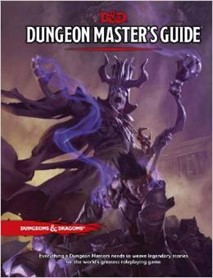 Well, at last the Dungeon Master’s Guide has been released, which allows all of us playing D&D 5E to finally have the full system and start properly evaluating what it is and what it does.
Well, at last the Dungeon Master’s Guide has been released, which allows all of us playing D&D 5E to finally have the full system and start properly evaluating what it is and what it does.
My first impressions of the DMG? Pretty favourable. I’ve been spending a lot of time with the system for creating monsters and – in particular – assigning their Challenge Ratings. It’s a very interesting system. Basically, you work out a defensive CR and an offensive CR, then average them to come up with a final value. The defensive CR is determined by how many hit points a monster has, then modified by its AC, while offensive CR is determined by the average damage it deals over the first three rounds of combat, then modified by the attack bonus/DC of its major attacks. And both offensive and defensive CRs are modified a little by other special abilities.
This system is likely to fall down lot in certain circumstances. Consider a monster with AC 23 and 10 hit points. According to the system, that gives it a defensive CR of about 5 (or possibly 2, depending on how you read the system), but you’re also describing a monster that dies to a simple magic missile spell. Moving too far from the baseline is going to give these weird results. You do have to be very careful of glass cannons (really dangerous offensive monsters that die in a single round) or grind monsters (really weak monsters that take forever to kill), so if you’re creating your first monsters, paying attention to the baselines for any given CR is likely to be useful. (I’m a bit dubious of the guideline that every 2 points of AC over the base given by the CR changes the CR by 1; I expect there’s a more accurate calculation.)
By far the most interesting part of these monster CRs has been how many hit points a monster really needs to survive. It’s a lot. A monster doesn’t even hit the CR 1 on the defensive charts until it reaches 71 hit points.
Historically, that’s a lot of hit points. In the old AD&D, before Constitution modifiers started affecting hit points for monsters, you had to be a 16 Hit Dice creature before you had that many hit points (on average). And 16 Hit Dice monsters were incredibly rare. Ignoring the unique demons, we get Aerial Servant, a few dinosaurs, the largest and oldest dragons, the largest elementals, the storm giant, the iron golem, big hydras, titans, the giant sea turtle(!) and whales.
It’s a bit hard to tell if it’s entirely accurate. The Barlgura in the new MM has only 68 hit points (8d10+24), but a challenge rating of 5, derived primarily from its attacks. Possibly – it does an average of 29 damage per round, which equates to about a CR of 5 or thereabouts. It’s not like the Barlgura has great defenses – AC 15, and only resistant to cold, fire and lightning. Although there are monsters in the MM that follow the values pretty closely (see the Giants, for instance), there are a number that don’t. Which gives people like me, who like analysing the maths behind the system, a number of irritations to work through.
It’s quite possible that the defensive CR is based on how tough it had to be to survive 3 rounds against a standard party of that level, but more research is needed!
Of course, the DMG wasn’t finalised when the CRs for the Monster Manual were being written, so there may be a few things that slipped through the cracks. That said, I’ve got a feeling that the hit point ranges in the DMG are actually pretty good, especially given how much damage player characters can put out each round. The upshot of this is that there are a lot of monsters that will die quicker than you might expect for their CR. It’s be a while I’ve racked up enough hours with the new system to really comment on that.
The highest level game I’m currently running is Hoard of the Dragon Queen. Next session, we’re entering the final episode of that book, although the characters are only 6th level at present. (Yes, there’s one session report I still have to write and post). We’ll start on Rise of Tiamat early in 2015, and I hope to have a retrospective review of Hoard up then as well. I’m also mindful that I’m terribly behind on my “Running Hoard” articles, but a number of other projects have been requiring my attention.
Otherwise, there are a lot of really great, inspirational tables in the new DMG. Including random dungeon tables. And tables to help stock dungeons.
And, of course, it also has the magic items, which make up a significant part of the book. It feels like half the book, although it’s closer to a quarter. The illustrations for the magic items are great.
One thing I still don’t really know is what you do with all the money you accumulate. Build strongholds? Could be.
Anyway, the new Dungeon Master’s Guide looks great. Enjoy!
